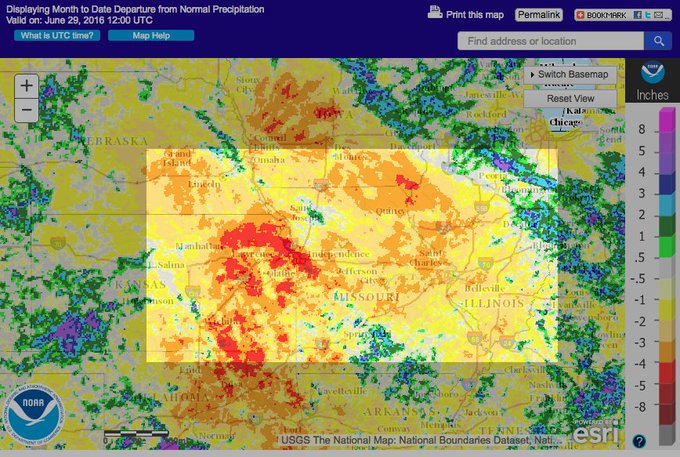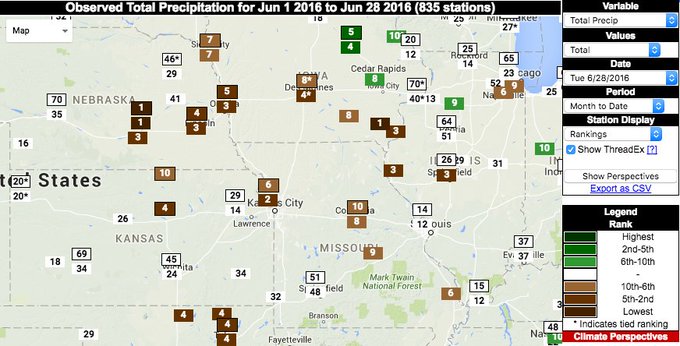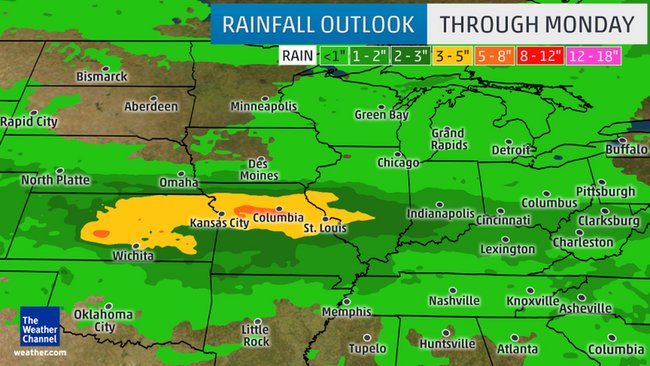If you’re one of the millions of Americans who plan to take at least
one flight this summer, take heart: you are remarkably well protected
from weather during your flight, especially considering the risks that
U.S. passengers faced not that long ago. From the 1970s to the 1990s,
more than 800 fliers perished in U.S. commercial airline crashes that
were linked to
microbursts, small but intense downdrafts
generated by thunderstorms. It took years of persistence from scientists
to raise awareness of the issue and solve the problem. But solve it
they did, by developing warning systems that took advantage of Doppler
radar, surface wind sensors, and sophisticated software. Thanks to these
systems, the last fatal crash of a U.S. passenger plane attributed to a
microburst
was on July 2, 1994,
when a US Airways flight crashed near the Charlotte-Douglas
International Airport, killing 37. As of this weekend, we’ll have put
that disaster 22 years behind us.
 Figure 1.
Figure 1. A microburst emerges from a thunderstorm downdraft. Image credit:
NWS/Birmingham, AL.
 Figure 2.
Figure 2.
Depending on the amount of moisture in a thunderstorm and its
environment, a microburst may be “dry” (left) or “wet” (right). Both
types can be dangerous to aircraft.
A video by photographer Brian Snider shows the formation of a dramatic wet microburst near Tucson in August 2015. Image credit: NOAA.
A stealthy villainMicrobursts
emerged as a major threat when the mid-century boom in consumer
aviation put thousands more flights aloft. It was in the 1970s that the
eminent storm researcher T. Theodore Fujita analyzed the risk from
localized downdrafts related to convection (showers and thunderstorms).
First trained as a mechanical engineer, Fujita
took a research flight in 1945
over the debris left by the bombs that struck Hiroshima and Nagasaki
and observed starburst damage patterns emanating outward from the point
of the bomb impact. Later, while surveying damage from the Super
Outbreak of tornadoes of April 3, 1974, Fujita recognized similar
starburst patterns, and he concluded that some of the damage must have
resulted from descending wind bursts.
The next year, an Eastern Airlines flight crashed while landing at John F. Kennedy International Airport in New York
on June 24, 1975, killing 113. Fujita was enlisted to help analyze the disaster.
In a 1976 report,
he remarked on “four to five cells of intense downdrafts which are to
be called ‘downburst cells’. Apparently, those aircraft which flew
through the cells encountered considerable difficulties in landing,
while others landed between the cells without even noticing the danger
areas on both sides of the approach path.” Fujita estimated that the
peak downdraft speed several hundred feet above ground was up to eight
times higher than conventional thinking would have predicted. Alas, he
added, “there is no way of predicting the occurrence of these phenomena
both in time and space.”
Even with very limited data, Fujita’s
legendary analytic skills enabled him to see the core process at work:
“In general, the air near the ground spreads out violently from the
‘outburst center,’ the spreading center above the ground. Unless a
heading correction is made immediately, an aircraft in the crosswind
burst will drift away from its expected course. If an aircraft flies
straight into the outburst center, its indicated airspeed will increase
momentarily followed by a high rate of sink. Before the aircraft can
break out of the downburst cell, its indicated air speed will drop
suddenly, due to an increase in the tailwind component.”
 Figure 3.
Figure 3.
Diagram showing how a microburst could bring down an aircraft that
flies directly through it. Modern warning systems now allow air traffic
controllers to steer passenger planes safely around microbursts. Image
credit: NCAR Research Applications Laboratory.
From dismissal to acceptanceFujita’s ideas faced widespread skepticism,
as noted by Josh Chamot
(National Science Foundation, or NSF): “Until the mid-1970s, most
researchers believed that downdrafts would substantially weaken before
reaching the ground and not pose a threat to aircraft. They blamed
tornadoes and gust fronts as the primary causes of storm damage.” After
the JFK crash, the FAA developed a simple cluster of anemometers called
LLWAS
that could detect wind shear related to large-scale phenomena such as a
frontal passage, but the LLWAS sensors were not close enough together
to detect microbursts and other crucial small-scale features.
Meanwhile,
Fujita and colleagues at the National Center for Atmospheric Research
(NCAR) carried out several field campaigns with NSF support, designed to
convince scientists and policymakers of the hazard and figure out how
to address it. The first of these was Project NIMROD (Northern Illinois
Meteorological Research on Downburst). On May 29, 1978, Fujita and
NCAR’s James Wilson became the first scientists to detect a microburst
on radar. “It was right on top of us,” Wilson told me
in a 2010 interview. After this event, Fujita created a new category,
microbursts, to denote
downbursts less than 4 kilometers (2.5 miles) across.
Project
NIMROD detected about 50 microbursts. A follow-up project in 1982, JAWS
(Joint Airport Weather Studies) found dozens more near Denver’s
now-defunct Stapleton International Airport. When JAWS kicked off its
operations that summer, “the FAA was still not ready to admit there was
such a thing as a microburst,” according to Wilson. But midway through
the project,
on July 9, 1982,
a Pan Am aircraft was forced down by a microburst in a residential
neighborhood in Kenner, Louisiana, killing all 145 people on board and 8
others on the ground. That calamity helped jump-start FAA funding for
the remainder of the summer. The agency’s involvement in research
accelerated further after a
microburst-related 1985 Delta crash near Dallas-Fort Worth International Airport took 137 lives.
 Figure 4.
Figure 4.
NCAR’s John McCarthy spent much of his time during the summers of 1984
and 1985 in the control tower of Denver’s Stapleton International
Airport during the CLAWS project (Classify, Locate, Avoid Wind Shear).
Image credit: UCAR.
Several more field projects followed, as
did NCAR’s development of an enhanced version of the LLWAS system that’s
now in place at more than 100 U.S. airports. NCAR and MIT’s Lincoln
Laboratory also began collaborating with the FAA to develop a
radar-based warning system called Terminal Doppler Weather Radar. TDWR
systems were deployed at deployed at 45 U.S. airports in the late 1980s
and 1990s, parallel with the
NWS NEXRAD deployment. Along with the warning system, there was
newfound pilot awareness
of the wind shear hazard. All of the world’s commercial jet pilots were
soon required to take part in a wind shear training program, and a
powerful series of videotapes featured pilots sharing their stories of
microburst encounters. Together, these innovations led to the essential
vanquishing of microburst-related accidents on U.S. passenger planes
since the mid-1990s.
Outside the U.S., “most international
airports have no wind shear protection,” said Bruce Carmichael, director
of NCAR’s Aviation Applications Program. “However, the new generation
of aircraft radar systems include forward-looking wind shear warnings,
so there is a good deal of capability inherent in the aircraft.”
In the realm of
general aviation
(all civilian flights outside of scheduled passenger service), wind
shear remains a deadly threat, because most flights involve aircraft and
airports that lack the means of detecting wind shear. Still, there is
only an average of about 10 shear-related fatalities per year in U.S.
general aviation, compared to the
400-plus general aviation deaths related to weather hazards as a whole.
 Figure 5.
Figure 5.
An intense hailstorm bears down on the NWS NEXRAD radar located at
Front Range Airport, just southeast of Denver International Airport, on
May 21, 2014. A separate radar at DIA that focuses on smaller-scale
phenomena is part of the FAA’s Terminal Doppler Weather Radar network.
The storm was part of a multiday outbreak of severe weather from the
Rockies to the Northeast U.S. (May 18-23) that
caused $4 billion in damage. Image credit: Bob Henson.
Safer skies overall: just one fatal passenger crash in nearly a decadeNot
only are U.S. airline passengers far safer from microbursts than they
were decades ago, but they’ve been remarkably safe from other weather
hazards—and just about all hazards, for that matter.
On August 27, 2006,
all 47 passengers aboard a Delta Connection flight were killed in a
crash at the Lexington’s Blue Grass Airport near Lexington, KY, that was
attributed to pilot error. Since then, there has only been one fatal
accident on a U.S. passenger plane: a Continental Connection flight that
crashed near Buffalo, NY,
on February 12, 2009,
killing all 45 passengers. This crash was also attributed to pilot
error. For the nation to go nearly a decade with just one fatal accident
on U.S. passenger planes would have been unthinkable as recently as the
1990s, when fatalities were a near-annual occurrence.
Americans are also
much safer on the road:
highway deaths are down by close to 20,000 per year compared to the
1970s and by about 10,000 per year compared to the 1990s. Unfortunately,
a big spike occurred in 2015, when traffic deaths rose by an estimated
8% over the previous year, equating to some 2800 additional deaths. This
was the
largest year-over-year percentage increase in 50 years,
according to the National Safety Council. While we don’t know exactly
what caused this spike (increased traffic and growing phone-related
distraction are possibilities), we do know that weather continues to be a
major factor in highway safety. Roughly 3400 people are killed each
year when driving in rain, and roughly 5700 on wet roads,
according to the Federal Highway Administration.
The
take-home message for travelers this summer: don’t worry too much about
weather hazards if you’re a passenger on a commercial flight--but when
you’re on the road, do everything that you can to drive safely and
defensively, especially during adverse conditions. That text message can
wait!
I'll be back with a new post by Friday afternoon,
including updates on the tropical cyclone likely to form off the coast
of Mexico in the next few days and the potential for very heavy rains
across the Central Plains and Midwest into next week. PS: If you're
hearing claims of "unprecedented" jet stream flow from the Northern to
the Southern Hemisphere, check out the
excellent debunking just published by Jason Samenow at Capital Weather Gang.
Bob Henson








 Debris lies waist-deep in the galley after the penetration of Hugo's eyewall
Debris lies waist-deep in the galley after the penetration of Hugo's eyewall A WC-130 aircraft similar to the plane that was lost in Typhoon Bess.
A WC-130 aircraft similar to the plane that was lost in Typhoon Bess.  Neptune P2V similar to the lost Hurricane Hunter
Neptune P2V similar to the lost Hurricane Hunter  Radar imagery from Hurricane Patricia as it was nearing maximum intensity. From NOAA 43/NOAA P-3 aircraft.
Radar imagery from Hurricane Patricia as it was nearing maximum intensity. From NOAA 43/NOAA P-3 aircraft. Tropical
Storm Irene moving over the island of St. Croix. Observations from a
departing hurricane hunter on the evening of August 21, 2011 and from
radar in San Juan, Puerto Rico
Tropical
Storm Irene moving over the island of St. Croix. Observations from a
departing hurricane hunter on the evening of August 21, 2011 and from
radar in San Juan, Puerto Rico






 Percent of flood-related deaths by situation from 1995-2010, excluding Hurricane Katrina flood deaths.
Percent of flood-related deaths by situation from 1995-2010, excluding Hurricane Katrina flood deaths. (MARIANA MENDEZ/AFP/Getty Images)
(MARIANA MENDEZ/AFP/Getty Images)









